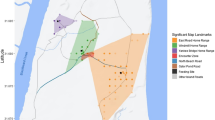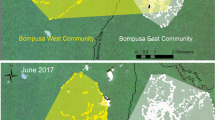Summary
Periodically, members of captive Lemur social groups target others for intense aggression. Over periods of several days, weeks, and sometimes months, one to three lemurs persistently follow and attack one or two particular group mates until the targets no longer associate with their group. Episodic targeting aggression is nonrandom with regard to time of year, group size and sex ratio, and the kinship, age, and gender of targets. The vast majority of episodes observed over the past 18 years at the Duke University Primate Center (DUPC) has occurred between like-sex adolescents and adults in conjunction with estrous cycling or infant births and most often after groups have reached apparent critical sizes. When unrelated adults have shared group membership, members of one family have almost invariably first targeted members of the other. In several groups, entire matrilines have gradually been evicted by members of another across periods of several years. When non-relatives have been absent, lemurs have evicted relatives that had previously formed separate subgroups. Episodic targeting aggression has been documented at the DUPC in over a dozen different social groups, comprising three different species. The phenomenon occurs repeatedly in groups held in a variety of large outdoor runs as well as in outdoor enclosures providing naturalistic space and physical structure. More-over, an appreciable number of recent observations in Madagascar suggest that the patterns we have documented well represent the phenomenon as it occurs in the wild. Targeting aggression based on group size, sex ratio, kinship and gender has been reported for no other primate taxon. We suggest that episodic targeting aggression reflects heretofore undescribed tactics in reproductive competition that may characterize many lemurid and indriid taxa. As such, the phenomenon has broad implications for the structure of lemur social groups and populations. Provisional models of the social dynamics and histories of Lemur social groups are presented for evaluation during upcoming field work.
Similar content being viewed by others
References
Bogart MH, Kumamoto AT, Lasley BL (1977) A comparison of the reproductive cycle of three species of Lemur. Folia Primatol 28:134–143
Budnitz N, Dainis K (1975) Lemur catta: Ecology and behavior. In: Tattersall I, Sussman RW (eds) Lemur biology. Plenum Press, New York, 219–235
Chepko-Sade BD, Oliver TJ (1979) Coefficient of genetic relationship and the probability of intragenealogical fission in Macaca mulatta. Behav Ecol Sociobiol 5:263–278
Colquhoun IC (1987) Dominance and “fall-fever:” the reproductive behaviour of male brown lemurs (Lemur fulvus). Canad Rev Phys Anthropol 6:10–19
Evans CS, Goy RW (1968) Social behaviour and reproductive cycles in captive ring-tailed lemurs (Lemur catta). J Zool Lond 156:181–197
Foerg R (1982) Reproductive behavior in Varecia variegata. Folia Primatol 38:108–121
Ganzhorn JU (1986) Feeding behavior in Lemur catta and Lemur fulvus. Int J Primatol 7:17–30
Ganzhorn JU (1988) Food partitioning among Malagasy primates. Oecologia 75:436–450
Glander KE, Rabin DP (1983) Food choice from endemic North Carolina tree species by captive prosimians (Lemur fulvus). Am J Primatol 5:221–229
Harrington J (1975) Field observations of social behavior of Lemur fulvus fulvus. In: Tattersall I, Sussman RW (eds) Lemur biology. Plenum Press, New York, pp 259–279
Janson CH, van Schaik CP (1988) Recognizing the many faces of primate food competition: methods. Behaviour 105:165–185
Jolly A (1966) Lemur behavior: a Madagascar field study. The University of Chicago Press, Chicago
Jolly A (1967) Breeding synchrony in lemurs. In: Altmann SA (ed) Social communication among primates. University of Chicago Press, Chicago, pp 3–13
Jolly A (1984) The puzzle of female feeding priority. In: Small M (ed) Female primates: studies by women primatologists. Liss, New York, pp 197–215
Jolly A (1985) The evolution of primate behavior. Macmillan, New York
Jones KC (1983) Inter-troop transfer of Lemur catta males at Berenty, Madagascar. Folia Primatol 40:145–160
Kappeler PM (1987) Reproduction of the crowned lemur (Lemur coronatus) in captivity. Am J Primatol 12:497–503
Klopfer PH, Dugard J (1976) Patterns of maternal care in lemurs. III. Z Tierpsychol 40:210–220
Kress JH, Conley JM, Eaglen RH, Ibanez AE (1978) The behavior of Lemur variegatus, Kerr 1792. Z Tierpsychol 48:87–99
Macedonia JM (1986) Individuality in a contact call of the ringtailed lemur (Lemur catta). Am J Primatol 11:163–179
Mertl-Millhollen A, Gustafson H, Budnitz N, Dainis K, Jolly A (1979) Population and territory stability of the Lemur catta at Berenty, Madagascar. Folia Primatol 31:106–122
Pereira ME, Izard MK (1989) Lactation and care for unrelated infants in forest-living ringtailed lemurs. Am J Primatol (in press)
Pereira ME, Simons EL (1986) Male resistance and female attraction to potential immigrant males in semi-free-ranging ringtailed lemurs. Am J Primatol 10:422
Pereira ME, Klepper A, Simons EL (1987) Tactics of care for young infants by forest-living ruffed lemurs (Varecia variegata variegata): ground nests, parking, and biparental guarding. Am J Primatol 13:129–144
Pereira ME, Seeligson ML, Macedonia JM (1988) The behavioral repertoire of the black-and-white ruffed lemur, Varecia variegata variegata (Primates: Lemuridae). Folia Primatol 51:1–32
Petter JJ (1962) Recherches sur l'ecologie et l'ethologie des Lemuriens malgaches. Mem Mus Nat Hist Nat Ser A Zool 27:1–146
Petter JJ, Albignac R, Rumpler Y (1977) Faune de Madagascar. Mammiferes lemuriens, vol 44. Orstom, CNRS, Paris
Pollock JI (1977) The ecology and sociology of feeding in Indrii. In: Clutton-Brock TH (ed) Primate ecology. Academic Press, New York, pp 38–68
Pollock JI (1979a) Female dominance in Indri indri. Folia Primatol 31:143–164
Pollock JI (1979b) Spatial distribution and ranging behavior in lemurs. In: Doyle GA, Martin RD (eds) The study of prosimian behavior. Academic Press, New York, pp 359–410
Pusey AE, Packer C (1987) Dispersal and philopatry. In: Smuts BB, Cheney DL, Seyfarth RM, Wrangham RW, Struhsaker TT (eds) Primate societies. University of Chicago Press, Chicago, pp 250–266
Rasmussen DT (1985) A comparative study of breeding seasonality and litter size in eleven taxa of captive lemurs (Lemur and Varecia). Int J Primatol 6:501–517
Richard A (1978) Behavioral variation. Presses, Cranbury NJ
Richard A (1985a) Social boundaries in a Malagasy prosimian, the sifaka (Propithecus verreauxi). Int J Primatol 6:553–568
Richard A (1985b) Primates in nature. Freeman, New York
Richard A (1987) Malagasy prosimians: female dominance. In: Smuts BB, Cheney DL, Seyfarth RM, Wrangham RW, Struhsaker TT (eds) Primate societies. University of Chicago Press, Chicago, pp 25–33
Richard A, Heimbuch R (1975) An analysis of the social behavior of three groups of Propithecus verreauxi. In: Tattersall I, Sussman RW (eds) Lemur biology. Plenum Press, New York, pp 313–333
Smuts BB (1985) Sex and friendship in baboons. Aldine, Hawthorne
Sussman RW (1972) An ecological study of two Madagascan primates: Lemur fulvus rufus (Audebert) and Lemur catta (Linnaeus). PhD dissertation, Duke University, Durham
Sussman RW (1974) Ecological distinctions in sympatric species of Lemur. In: Martin RD, Doyle GA, Walker AC (eds) Prosimian biology. University of Pittsburgh Press, Pittsburgh, pp 75–108
Sussman RW (1975) A preliminary study of the behavior and ecology of Lemur fulvus rufus, Audebert 1800. In: Tattersall I, Sussman RW (eds) Lemur biology. Plenum Press, New York, pp 237–258
Sussman RW (1977a) Feeding behavior of Lemur catta and Lemur fulvus. In: Clutton-Brock TH (ed) Primate ecology. Academic Press, New York, pp 1–37
Sussman RW (1977b) Socialization, social structure, and ecology of two sympatric species of Lemur. In: Chevalier-Skolnikoff S, Poirier FE (eds) Primate bio-social development. Garland, New York, pp 515–528
Sussman RW, Richard A (1974) The role of aggression among diurnal prosimians. In: Holloway R (ed) Primate aggression, territoriality, and xenophobia: a comparative perspective. Academic Press, New York, pp 49–76
Tattersall I (1977) Ecology and behavior of Lemur fulvus mayottensis (Primates, Lemuriformes). Anthrop Papers Am Mus Nat Hist 54:422–482
Tattersall I (1982) The primates of Madagascar. Columbia University Press, New York
Taylor LL (1985) Influences of kinship and gender on dominance relationships in ringtailed lemurs. Am J Primatol 8:369
Taylor LL (1986) Kinship, dominance and social organization in a semi-free-ranging group of ringtailed lemurs (Lemur catta). PhD dissertation, Washington University. St Louis
Taylor LL (1987) Individual rank, mean matrilineal rank, and infant survival in ringtailed lemurs (Lemur catta). Am J Phys Anthropol 72:261
Taylor LL, Sussman RW (1985) A preliminary study of kinship and social organization in a semi-free-ranging group of Lemur catta. Int J Primatol 6:601–614
Tilson R (1981) Family formation strategies of Kloss gibbons (Hylobates klossii). Folia Primatol 35:259–287
Vick LG (1975) The role of interindividual bonds in captive Lemur fulvus. Am J Phys Anthropol 42:336
Vick LG (1977) The role of interindividual relationships in two troops of captive Lemur fulvus. PhD dissertation, University of North Carolina at Chapel Hill, Chapel Hill
Vick LG (1983) From outdoor run to natural habitat enclosure: changes in behavior in a Lemur fulvus troop. Am J Primatol 4:347
Vick LG (1985) Intratroop agonistic patterns among captive Lemur fulvus. Am J Primatol 8:369–370
Vick LG (1988) Tactics of reproductive competition among female lemurs. Am J Primatol 14:450
Vick LG, Conley JM (1976) An ethogram for Lemur fulvus. Primates 17:125–144
Vick LG, Keith-Lucas T, Keith-Lucas L, Overdorff D (1986) Changes in social structure and behavior in a group of released Lemur catta. Am J Primatol 10:437
Waser P, Jones WT (1983) Natal philopatry among solitary mammals. Q Rev Biol 58:355–390
Weiss ML, Wilson V, Chan C, Turner T, Jeffreys AJ (1988) Application of DNA fingerprinting probes to Old World monkeys. Am J Primatol 16:73–79
Wrangham R (1980) An ecological model of female-bonded primate groups. Behaviour 75:262–299
Author information
Authors and Affiliations
Rights and permissions
About this article
Cite this article
Vick, L.G., Pereira, M.E. Episodic targeting aggression and the histories of Lemur social groups. Behav Ecol Sociobiol 25, 3–12 (1989). https://doi.org/10.1007/BF00299705
Received:
Accepted:
Issue Date:
DOI: https://doi.org/10.1007/BF00299705




